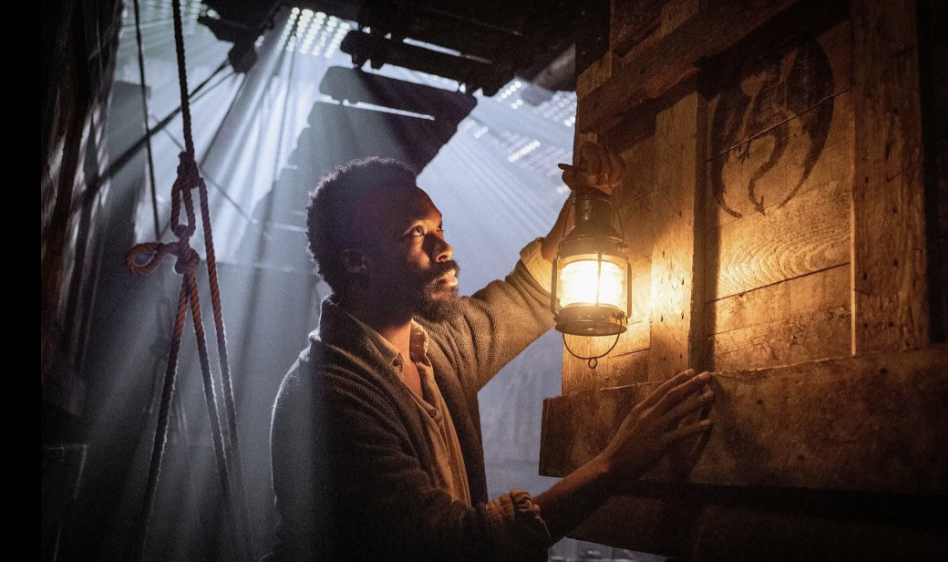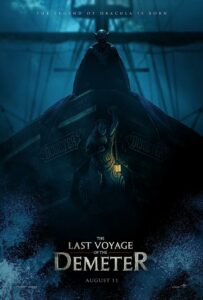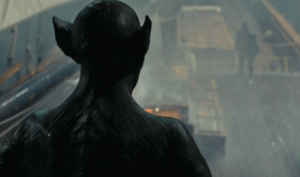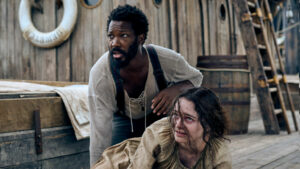Directed by André Øvredal | Written by Bragi F. Schut and Zak Olkewicz, based on a chapter of Bram Stoker’s Dracula | 118 min | ▲▲▲△△ | VOD
It’s hard to argue against the notion we’ve seen this kind of thing before — this film’s a solemn, genuine throwback to gothic creeps of Hammer Horror and the like, the period drama intermingled with a classic vampire picture. What The Last Voyage of the Demeter does to lean into the familiarity — while also tapping a fresh vein — is illuminate a sliver of the original Stoker novel, the part where the monster is transported by ship from Transylvania to England, where weeks later the vessel arrives without a living member of its crew.
None of these plot points are spoiler for anyone who’s read the novel or seen the more accurate adaptations, and it’s all set up in the first five minutes of this picture on the rocky, windswept shores of Whitby, Yorkshire, before flashing back to a port on the Black Sea.
The key crew members are served up to us early — and to the demon later — starting with Clemens (Corey Hawkins), a well-educated Black man from England, a doctor and a seeker of knowledge. Also aboard is whiskery Captain Eliot (Liam Cunningham, not a far cry from his Game of Thrones pirate), his curly-haired moppet of a son, Toby (Woody Norman), First Mate Wojcek (David Dastmalchian, terrific in a meatier role than we often see him), and various other seadogs — Stefan Kapicic makes an impression as a sailor with a family, as does Jon Jon Briones, a god-fearing chef. Later on we’ll be introduced to Anna (Aisling Franciosi), who’s in thrall to the vampire (Javier Botet) but really here to offer insight into the undead’s evil influence.
I’ve seen reviewers compare the picture to Alien, unflatteringly, what with the monster picking off its prey over the course of the film and able to infect them, too, while the crew debate their bonuses. I get that inclination, but it’s too reductive a comparison — when Alien was released they called it a haunted house in space. This is a haunted house at sea. All this material is rooted in the same sources, and this one goes back to an original.
Øvredal simply isn’t interested in reinventing the wheel here, he’s just wanting to tell a suspenseful tale of a doomed ship and take his time doing it. Much of that deliberate storytelling is welcome as it allows us to feel the stakes with these characters. a small group of effective jump-scares keep things interesting and the gore splashes along with salty sea-brine. CGI effects are elegantly applied, for the most part, and while we maybe get one too many shots of the ship sailing into a digital sunset, when the Demeter is lashed by storms you’ll feel the swells.
Where the ship really starts to list is in the final act. Just as the number of healthy, able-bodied crew dwindles conversations about the nature of the life, death, the universe, and everything grow more robust and the pacing bags. The timing is poor — we know the fate of these sailors so let’s get to it and our famous fanged fiend!
It helps not at all that long before the conclusion the crew discover “where the devil sleeps” and yet don’t do much with this relevant information, while a coda on dry land suggests the longer story from the novel of which we don’t need to be reminded.
The film’s old reliable wooden stake-in-the-heart is its fidelity to genre and to the source material. No matter how many times we’ve been visited by the vampiric Prince of Darkness, the filmmakers here lean into the fundamentals like it’s the first time.













